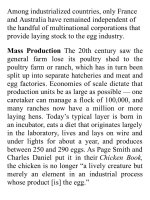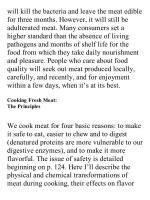On food and cooking the science and lore of the kitchen ( PDFDrive ) 292
Bạn đang xem bản rút gọn của tài liệu. Xem và tải ngay bản đầy đủ của tài liệu tại đây (122.53 KB, 2 trang )
willkillthebacteriaandleavethemeatedible
forthreemonths.However,itwillstillbe
adulteratedmeat.Manyconsumersseta
higherstandardthantheabsenceofliving
pathogensandmonthsofshelflifeforthe
foodfromwhichtheytakedailynourishment
andpleasure.Peoplewhocareaboutfood
qualitywillseekoutmeatproducedlocally,
carefully,andrecently,andforenjoyment
withinafewdays,whenit’satitsbest.
CookingFreshMeat:
ThePrinciples
Wecookmeatforfourbasicreasons:tomake
itsafetoeat,easiertochewandtodigest
(denaturedproteinsaremorevulnerabletoour
digestiveenzymes),andtomakeitmore
flavorful.Theissueofsafetyisdetailed
beginningonp.124.HereI’lldescribethe
physicalandchemicaltransformationsof
meatduringcooking,theireffectsonflavor
andtexture,andthechallengeofcooking
meatwell.Thesechangesaresummarizedin
theboxonp.152.
HeatandMeatFlavor
Rawmeatistastyratherthanflavorful.It
providessalts,savoryaminoacids,anda
slightaciditytothetongue,butofferslittlein
thewayofaroma.Cookingintensifiesthe
tasteofmeatandcreatesitsaroma.Simple
physicaldamagetothemusclefiberscauses
themtoreleasemoreoftheirfluidsand
thereforemorestimulatingsubstancesforthe
tongue.Thisfluidreleaseisatitsmaximum
whenmeatisonlylightlycooked,ordone
“rare.”Asthetemperatureincreasesandthe
meatdriesout,physicalchangegiveswayto
chemicalchange,andtothedevelopmentof
aromaascellmoleculesbreakapartand
recombinewitheachothertoformnew
moleculesthatnotonlysmellmeaty,butalso









